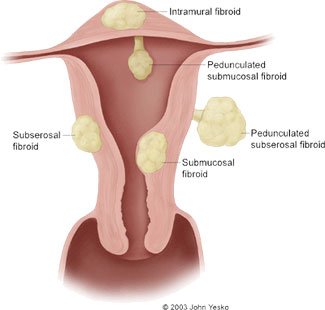Treatments
Uterine Fibroids Treatments
 A uterine fibroid embolization (UFE) shrinks fibroids in your uterus by cutting off their blood supply. At Northwestern Medicine, skilled interventional radiologists use imaging technology and a thin catheter to inject small particles into the arteries that supply blood in your uterus. These particles, most commonly made from polyvinyl alcohol, adhere to the blood vessel wall, causing a clot to develop that blocks the blood supply. Once the blood supply is gone, the fibroids shrink or die and your symptoms typically improve or stop completely.
A uterine fibroid embolization (UFE) shrinks fibroids in your uterus by cutting off their blood supply. At Northwestern Medicine, skilled interventional radiologists use imaging technology and a thin catheter to inject small particles into the arteries that supply blood in your uterus. These particles, most commonly made from polyvinyl alcohol, adhere to the blood vessel wall, causing a clot to develop that blocks the blood supply. Once the blood supply is gone, the fibroids shrink or die and your symptoms typically improve or stop completely.
A UFE procedure usually lasts less than one hour and calls for just a small incision in your femoral artery. It may be performed on an outpatient basis or require a one-night stay in the hospital.
Benefits of UFE
If you are suffering from severe symptoms of uterine fibroids, UFE offers many possible benefits, including:
- Preservation of your uterus
- Decrease in heavy menstrual bleeding
- Decrease in urinary dysfunction
- Decrease in pelvic pain and/or pressure
- Virtually no blood loss
- Covered by most insurance companies
- Shorter hospital stay, faster return to work and fewer complications after 30 days, when compared to having a hysterectomy
- Greater confidence, with reduced risk of soiling
- Improved physical and emotional well-being
Risks of UFE
Some women go through menopause following a UFE procedure. This is particularly true for women older than 45. Your uterus is not removed during UFE, so you could still become pregnant. However, more research is needed to determine exactly how this procedure affects fertility and pregnancy. Additional complications are possible with any procedure. If you have UFE, you may experience:
- Abnormal bleeding
- Injury to your uterus
- Infection of your uterus or of the puncture site in the groin
- Hematoma at the puncture site in your groin
- Injury to the artery being used
- Blood clots
- Infertility
- Loss of menstrual periods
- Allergic reaction to X-ray dye
Post-embolization syndrome
Some women experience post-embolization syndrome, which is described as having flu-like symptoms. It can occur within a few hours or a few days of your UFE procedure. Typically, symptoms last anywhere from two to seven days and include:
- Pelvic pain and cramping
- Nausea and vomiting
- Low-grade fever
- Fatigue and discomfort
Medication can be given to help lessen the symptoms of post-embolization syndrome.






